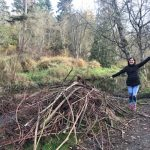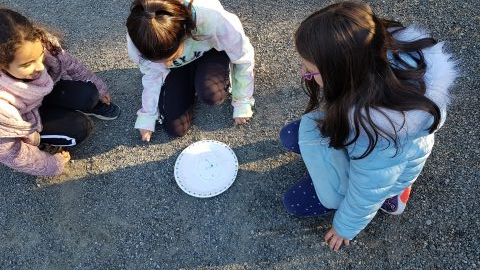Over this school year, Kristina Carley’s Div 6 Gr 3 and 4’s from University Highlands elementary have been exploring math outdoors in a variety of ways. Here are a few examples:
Sharing Data
As the class began to get to know one at the start of the year, they used questions and gathered data to explore tallies, bar graphs, and pictographs. They also graphed observations outside. Some inquiry questions include:
- What characteristics can we use to group our found materials?
- How can we organize our data to compare and analyze what we have found?
- Which ways of representing help us easily recognize the differences between amounts?
Sundial and Time
Make sundials to explore math & science inquiry about time. Students made paper sundials and then took them home to explain to parents. Students also explored the rotation and revolution of the earth around the sun in an activity where students became models of the Earth and spun around to understand how this movement is responsible for the Sun rising and setting every day. They also discussed how the speed of the Earth’s rotation affects the length of one full day.
- Who developed the first clock
- Why are days, hours, months and years the length they are?
- How do other cultures measure time?
Instructions on making the sundial are here. Find some great information about the 13 moons of the Wsanec First Nation here.
Fibonacci Numbers
Division 6 explored patterns including Fibonacci numbers. After learning about them, we found them everywhere.
- Where can we find Fibonacci numbers outside?
- Where else can you find patterns around us?
1000 Sticks
To explore groups of 1000 and begin their number sense unit, division 6 made a pile of 1000 sticks. They were surprised at how long it took… and then how small the amount looked! Later, they connected their learning to a photo of a beaver dam that Ms. Carley found at the Burn’s Bog! It looked so similar to the groups of 1000 sticks! With each photo at the bog, students got more information to estimate how many sticks were in the beaver’s structure. The understanding of number sense, place value, ordering, comparing, adding, and subtracting has come a long way!
After estimating how many sticks were in the dam, students solved a numberless story problem about the beaver who might have built that dam. The next day, they were inspired to create our own story problems and came up with stories that had all sorts of math operations. Some were about addition, time, division, measurement, patterns, and more! Where can math live inside stories?
-K. Carley and D. Morgan

Leave a Reply